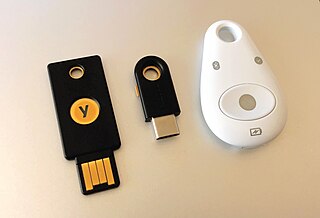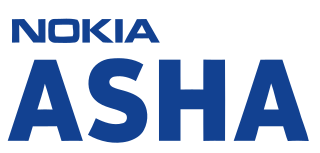
The Global System for Mobile Communications (GSM) is a standard developed by the European Telecommunications Standards Institute (ETSI) to describe the protocols for second-generation (2G) digital cellular networks used by mobile devices such as mobile phones and tablets. GSM is also a trade mark owned by the GSM Association. "GSM" may also refer to the voice codec initially used in GSM.

Short Message Service, commonly abbreviated as SMS, is a text messaging service component of most telephone, Internet and mobile device systems. It uses standardized communication protocols that let mobile phones exchange short text messages, typically transmitted over cellular networks.
Signalling System No. 7 (SS7) is a set of telephony signaling protocols developed in the 1970s that is used to set up and tear down telephone calls on most parts of the global public switched telephone network (PSTN). The protocol also performs number translation, local number portability, prepaid billing, Short Message Service (SMS), and other services.

A SIMcard is an integrated circuit (IC) intended to securely store an international mobile subscriber identity (IMSI) number and its related key, which are used to identify and authenticate subscribers on mobile telephone devices. SIMs are also able to store address book contacts information, and may be protected using a PIN code to prevent unauthorized use.
A5/1 is a stream cipher used to provide over-the-air communication privacy in the GSM cellular telephone standard. It is one of several implementations of the A5 security protocol. It was initially kept secret, but became public knowledge through leaks and reverse engineering. A number of serious weaknesses in the cipher have been identified.
Network switching subsystem (NSS) is the component of a GSM system that carries out call out and mobility management functions for mobile phones roaming on the network of base stations. It is owned and deployed by mobile phone operators and allows mobile devices to communicate with each other and telephones in the wider public switched telephone network (PSTN). The architecture contains specific features and functions which are needed because the phones are not fixed in one location.
An over-the-air update, also known as over-the-air programming, is an update to an embedded system that is delivered through a wireless network, such as Wi-Fi or a cellular network. These embedded systems include mobile phones, tablets, set-top boxes, cars and telecommunications equipment. OTA updates for cars and internet of things devices can also be called firmware over-the-air (FOTA). Various components may be updated OTA, including the device's operating system, applications, configuration settings, or parameters like encryption keys.

MIFARE is a series of integrated circuit (IC) chips used in contactless smart cards and proximity cards.

A one-time password (OTP), also known as a one-time PIN, one-time passcode, one-time authorization code (OTAC) or dynamic password, is a password that is valid for only one login session or transaction, on a computer system or other digital device. OTPs avoid several shortcomings that are associated with traditional (static) password-based authentication; a number of implementations also incorporate two-factor authentication by ensuring that the one-time password requires access to something a person has as well as something a person knows.
An international mobile subscriber identity-catcher, or IMSI-catcher, is a telephone eavesdropping device used for intercepting mobile phone traffic and tracking location data of mobile phone users. Essentially a "fake" mobile tower acting between the target mobile phone and the service provider's real towers, it is considered a man-in-the-middle (MITM) attack. The 3G wireless standard offers some risk mitigation due to mutual authentication required from both the handset and the network. However, sophisticated attacks may be able to downgrade 3G and LTE to non-LTE network services which do not require mutual authentication.

The HTC Universal is a Windows Mobile 5.0 Pocket PC PDA manufactured by High Tech Computer Corporation. It was the first 3G/UMTS-enabled Pocket PC PDA with a telecommunications function, and also the first to come with Windows Mobile 5.0 pre-installed.
SIM Application Toolkit (STK) is a standard of the GSM system which enables the subscriber identity module to initiate actions which can be used for various value-added services. Similar standards exist for other network and card systems, with the USIM Application Toolkit (USAT) for USIMs used by newer-generation networks being an example. A more general name for this class of Java Card-based applications running on UICC cards is the Card Application Toolkit (CAT).

Crypto1 is a proprietary encryption algorithm and authentication protocol created by NXP Semiconductors for its MIFARE Classic RFID contactless smart cards launched in 1994. Such cards have been used in many notable systems, including Oyster card, CharlieCard and OV-chipkaart.
Massachusetts Bay Transportation Authority v. Anderson, et al., Civil Action No. 08-11364, was a challenge brought by the Massachusetts Bay Transportation Authority (MBTA) to prevent three Massachusetts Institute of Technology (MIT) students from publicly presenting a security vulnerability they discovered in the MBTA's CharlieCard automated fare collection system. The case concerns the extent to which the disclosure of a computer security flaw is a form of free speech protected by the First Amendment to the United States Constitution.
Private GSM solutions appeared after the deregulation of the DECT guard band in some countries, allowing users and businesses to reduce their costs without impacting their performance, and to offer a number of value-added services. These benefits arose from the ability to create private mobile GSM networks, enabling mobile phone users to access the same services and features as users of a PBX extension.

Multi-factor authentication is an electronic authentication method in which a user is granted access to a website or application only after successfully presenting two or more pieces of evidence to an authentication mechanism. MFA protects personal data—which may include personal identification or financial assets—from being accessed by an unauthorized third party that may have been able to discover, for example, a single password.
Phone hacking is the practice of exploring a mobile device, often using computer exploits to analyze everything from the lowest memory and CPU levels up to the highest file system and process levels. Modern open source tooling has become fairly sophisticated to be able to "hook" into individual functions within any running app on an unlocked device and allow deep inspection and modification of its functions.
Mobile security, or mobile device security, is the protection of smartphones, tablets, and laptops from threats associated with wireless computing. It has become increasingly important in mobile computing. The security of personal and business information now stored on smartphones is of particular concern.

The Nokia Asha 310, also known as the Nokia Asha 310 or the Nokia ASHA 310 RM-911, was released in March 2013. It is the first in the line of the Asha range of phones to have dual subscriber identity module (SIM) slots and Wi-Fi connectivity. It was a reinvention of the Asha range to remain competitive with new Android devices. It cost $102.00 at its launch date. It has a touchscreen, comes with either a 2 or 4 GB micro SD card, and has 64 MB of RAM, a 2.0 MP camera and a battery that can last up to 600 hours in standby mode. The phone can play music for up to 54 hours or video for up to 9.5 hours, and has a maximum of 17 hours talk time (2G).
Osmocom is an open-source software project that implements multiple mobile communication standards, including GSM, DECT, TETRA and others.









